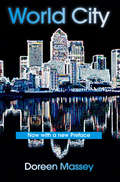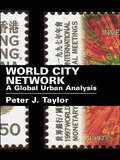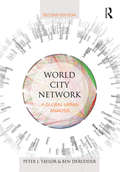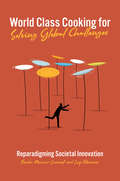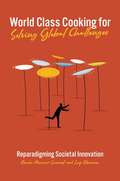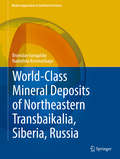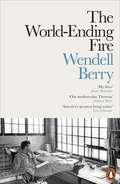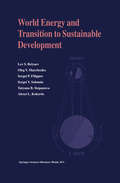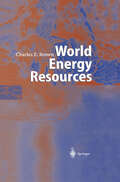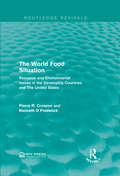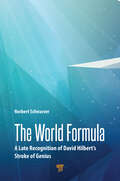- Table View
- List View
World City
by Doreen MasseyCities around the world are striving to be 'global'. This book tells the story of one of them, and in so doing raises questions of identity, place and political responsibility that are essential for all cities. World City focuses its account on London, one of the greatest of these global cities. London is a city of delight and of creativity. It also presides over a country increasingly divided between North and South and over a neo-liberal form of globalisation - the deregulation, financialisation and commercialisation of all aspects of life - that is resulting in an evermore unequal world. World City explores how we can understand this complex narrative and asks a question that should be asked of any city: what does this place stand for? Following the implosion within the financial sector, such issues are even more vital. In a new Preface, Doreen Massey addresses these changed times. She argues that, whatever happens, the evidence of this book is that we must not go back to 'business as usual', and she asks whether the financial crisis might open up a space for a deeper rethinking of both our economy and our society.
World City Network: A Global Urban Analysis
by Peter J. Taylor Ben DerudderWith the advent of multinational corporations, the traditional urban service function has 'gone global'. In order to provide services to globalizing corporate clients, the offices of major financial and business service firms across the world have formed a network. It is the myriad of flows between office towers in different metropolitan centres that has produced a world city network. Through an analysis of the intra-company flows of 100 leading global service firms across 315 cities, this book assesses cities in terms of their overall network connectivity, their connectivity by service sector, and their connectivity by world region. Peter Taylor's unique and illuminating book provides the first comprehensive and systematic description and analysis of the world city network as the 'skeleton' upon which contemporary globalization has been built. His analyses challenge the traditional view of the world as a 'mosaic map' of political boundaries. Written by one of the foremost authorities on the subject, this book provides a much needed mapping of the connecting relationships between world cities, and will be an enlightening book for students of urban studies, geography, sociology and planning.
World City Network: A Global Urban Analysis
by Peter J. Taylor Ben DerudderWith the advent of multinational corporations, the traditional urban service function has 'gone global'. In order to provide services to globalizing corporate clients, the offices of major financial and business service firms across the world have formed a network. It is the myriad of flows between office towers in different metropolitan centres that has produced a world city network. Through an analysis of the intra-company flows of 100 leading global service firms across 315 cities, this book assesses cities in terms of their overall network connectivity, their connectivity by service sector, and their connectivity by world region. Peter Taylor's unique and illuminating book provides the first comprehensive and systematic description and analysis of the world city network as the 'skeleton' upon which contemporary globalization has been built. His analyses challenge the traditional view of the world as a 'mosaic map' of political boundaries. Written by one of the foremost authorities on the subject, this book provides a much needed mapping of the connecting relationships between world cities, and will be an enlightening book for students of urban studies, geography, sociology and planning.
World City Network: A global urban analysis
by Peter J. Taylor Ben DerudderWith the advent of multinational corporations, the traditional urban service function has 'gone global'. In order to provide services to globalizing corporate clients, the offices of major financial and business service firms across the world have generated networks of work. It is the myriad of flows between office towers in different metropolitan centres that has produced a world city network. Taylor and Derudder's unique and illuminating book provides both an update and a substantial revision of the first edition that was published in 2004. It provides a comprehensive and systematic description and analysis of the world city network as the 'skeleton' upon which contemporary globalization has been built. Through an analysis of the intra-company flows of 175 leading global service firms across 526 cities in 2012, this book assesses cities in terms of their overall network connectivity, the regional configurations they form, and their changing position in the period 2000-12. Results are used to reflect on cities and city/state relations in the context of the global ecological and economic crisis. Written by two of the foremost authorities on the subject, this book provides a much-needed mapping of the connecting relationships between world cities, and will be a valuable resource for students of urban studies, geography, sociology and planning.
World City Network: A global urban analysis
by Peter J. Taylor Ben DerudderWith the advent of multinational corporations, the traditional urban service function has 'gone global'. In order to provide services to globalizing corporate clients, the offices of major financial and business service firms across the world have generated networks of work. It is the myriad of flows between office towers in different metropolitan centres that has produced a world city network. Taylor and Derudder's unique and illuminating book provides both an update and a substantial revision of the first edition that was published in 2004. It provides a comprehensive and systematic description and analysis of the world city network as the 'skeleton' upon which contemporary globalization has been built. Through an analysis of the intra-company flows of 175 leading global service firms across 526 cities in 2012, this book assesses cities in terms of their overall network connectivity, the regional configurations they form, and their changing position in the period 2000-12. Results are used to reflect on cities and city/state relations in the context of the global ecological and economic crisis. Written by two of the foremost authorities on the subject, this book provides a much-needed mapping of the connecting relationships between world cities, and will be a valuable resource for students of urban studies, geography, sociology and planning.
World Class Cooking for Solving Global Challenges: Reparadigming Societal Innovation
by Eunika Mercier-Laurent Leif EdvinssonWhen faced with new global challenges propelled by social, financial, economic, health and environmental crisis, the leaders of today need alternative answers to those posed by traditional policies. In this book, Mercier-Laurent and Edvinsson consider a cutting-edge thought methodology for solving global challenges - by looking at societal innovation through the lens of an analogy to cooking. How might we apply the power of cooking to connect imagination, knowledge, know-how and pleasure to real-world problems? Envisioning an ecosystem dynamic which connects various components, and requires multiple resources with the aim of securing sustainable well-being, the authors showcase initiatives for societal innovation which involve the use of diverse talents, evolving behaviours, thinking differently, adapting to the use of technology and close attention to human purpose. Demonstrating that the possibilities of technology are underused for solving critical problems because of the continual perpetuation of the same cognitive approaches, time and time again, this book makes a crucial intervention by serving up a new perspective on obtaining a sustainable and prosperous future that traditional approaches have so far not reached. By presenting a broad range of promising experiments from around the world, the authors inspire readers to re-imagine their idea of how societal innovation might be achieved. In this book they provide the first of many new recipes for successful global change-making.
World Class Cooking for Solving Global Challenges: Reparadigming Societal Innovation
by Eunika Mercier-Laurent Leif EdvinssonWhen faced with new global challenges propelled by social, financial, economic, health and environmental crisis, the leaders of today need alternative answers to those posed by traditional policies. In this book, Mercier-Laurent and Edvinsson consider a cutting-edge thought methodology for solving global challenges - by looking at societal innovation through the lens of an analogy to cooking. How might we apply the power of cooking to connect imagination, knowledge, know-how and pleasure to real-world problems? Envisioning an ecosystem dynamic which connects various components, and requires multiple resources with the aim of securing sustainable well-being, the authors showcase initiatives for societal innovation which involve the use of diverse talents, evolving behaviours, thinking differently, adapting to the use of technology and close attention to human purpose. Demonstrating that the possibilities of technology are underused for solving critical problems because of the continual perpetuation of the same cognitive approaches, time and time again, this book makes a crucial intervention by serving up a new perspective on obtaining a sustainable and prosperous future that traditional approaches have so far not reached. By presenting a broad range of promising experiments from around the world, the authors inspire readers to re-imagine their idea of how societal innovation might be achieved. In this book they provide the first of many new recipes for successful global change-making.
World-Class Mineral Deposits of Northeastern Transbaikalia, Siberia, Russia (Modern Approaches in Solid Earth Sciences #17)
by Bronislav Gongalsky Nadezhda KrivolutskayaThis book describes for the first time the complexity of the Northeastern Transbaikalia province of Russia. This province is one of the largest Early Proterozoic metallogenic provinces on Earth. It comprises three extra large deposits: Cu-sandstones Udokan, Fe-Ti-V and Cu-PGE Chiney, and REE Katugin. This book is a research study and includes geological, mineralogical, and geochemical data obtained by the authors from 30 field trips in the region, using XRF, ICP-MS, La-ICP-MS, EPMA, and the study of Sr, Nd, U-Pb isotopes in rocks and minerals. It demonstrates the complicated origin of Cu deposits comprising 50 Mt copper concentrated in sedimentary and magmatic rocks in this area.
The World-Ending Fire: The Essential Wendell Berry
by Wendell Berry'He is unlike anybody else writing today ... After Donald Trump's election, we urgently need to rediscover the best of radical America. An essential part of that story is Wendell Berry. Few of us can live, or even aspire to, his kind of life. But nobody can risk ignoring him' Andrew Marr'Wendell Berry is the most important writer and thinker that you have (probably) never heard of. He is an American sage' -James Rebanks, author of The Shepherd's Life Wendell Berry is 'something of an anachronism'. He began his life as the old times and the last of the old-time people were dying out, and continues to this day in the old ways: a team of work horses and a pencil are his preferred working tools. The writings gathered in The World-Ending Fire are the unique product of a life spent farming the fields of rural Kentucky with mules and horses, and of the rich, intimate knowledge of the land cultivated by this work. These are essays written in defiance of the false call to progress, and in defence of the local landscapes that provide our cultural heritage, our history, our home.In a time when our relationship to the natural world is ruled by the violence and greed of unbridled consumerism, Wendell Berry speaks out to defend the land we live on. With grace and conviction, he shows that we simply cannot afford to succumb to the mass-produced madness that drives our global economy. The natural world will not withstand it.Yet he also shares with us a vision of consolation and of hope. We may be locked in an uneven struggle, but we can and must begin to treat our land, our neighbours, and ourselves with respect and care. We must, as Berry urges, abandon arrogance and stand in awe.
World Energy and Transition to Sustainable Development
by Lev S. Belyaev Oleg V. Marchenko Sergei P. Filippov Sergei V. Solomin Tatyana B. Stepanova Alexei L. KokorinThis book presents the results of a study of long-term perspectives for energy development of the world and its main regions, performed at the Siberian Energy Institute of the Russian Academy of Sciences (Energy Systems Institute since 1998). The methodological approach, the 10-regional Global Energy Model (GEM-10R) of the world energy system, energy demand forecasts, data on energy resources and energy technologies, and results of calculations based on mathematical models are described. Particular attention is given to determination of energy requirements and peculiarities of its technological structure that are caused by mankind's necessary transition to sustainable development. Economic and ecological consequences of constraints on greenhouse gas emissions and scales of nuclear energy production, as well as assistance of developed countries to developing ones are investigated. Problems of cheap oil, gas and uranium resources depletion, fuel price growth, synthetic fuel production and new energy technology implementation are analysed. The book is intended for specialists in energy and economics, as well as students and postgraduate students of technical high schools and universities. ac
World Energy Resources: International Geohydroscience and Energy Research Institute
by Charles E. BrownWorld Energy Resources is an explanatory energy survey of the countries and major regions of the world, their geographic and economic settings, and signif icant inter-relationships. This book attempts to combine several interacting energy themes that encompass a historical development, energy issues and forecasts, economic geography, environmental programs, and world energy use. The main thrust of this book -World Energy Resources - is based on princi ples of energy science, applied geology, geophysics, and other environmental sciences as they relate to the exploration, exploitation, and production of resources in this country and throughout the world. This work is an analysis of the United States (USA) and world oil, gas, coal, and alternative energy resources and their associated issues, forecasts, and related policy. This book could not have been attempted without a broad geological exposure and international ge ographic awareness. Much information is scattered among federal and state agencies, schools, and other institutions, and this book has attempted to com bine some of the vast information base. This attempt can only skim the infor mation surface at best, but its regional and topical coverage is broad in scope. Part I introduces conventional energy resources and their historical develop ments, and includes chapters 1 to 7. The basic concepts and supporting facts on energy sources are presented here for the general education of energy analysts, policy makers, and scientists that desire a brief review of advanced technologies and history.
The World Food Situation: Resource and Environmental Issues in the Developing Countries and The United States (Routledge Revivals)
by Pierre R. Crosson Kenneth D FrederickAt the beginning of the 1970’s, global grain reserves were level and food prices were low however as the decade progressed crop production plummeted leading to a food crisis. Originally published in the aftermath in 1977, Crosson and Frederick set out to explore the ability of agricultural output to meet the global food demands of future generations. This study analyses how resources and environmental factors would affect food production in developing countries and the United States until the end of the 21st Century. The environmental impacts of land levels, fertiliser and pesticide use are explored in relation to the challenges of meeting food demands. This title will be of interest to students of environmental studies.
The World Food Situation: Resource and Environmental Issues in the Developing Countries and The United States (Routledge Revivals)
by Pierre R. Crosson Kenneth D FrederickAt the beginning of the 1970’s, global grain reserves were level and food prices were low however as the decade progressed crop production plummeted leading to a food crisis. Originally published in the aftermath in 1977, Crosson and Frederick set out to explore the ability of agricultural output to meet the global food demands of future generations. This study analyses how resources and environmental factors would affect food production in developing countries and the United States until the end of the 21st Century. The environmental impacts of land levels, fertiliser and pesticide use are explored in relation to the challenges of meeting food demands. This title will be of interest to students of environmental studies.
The World Formula: A Late Recognition of David Hilbert‘s Stroke of Genius
by Norbert SchwarzerSurely the reader had come across situations where he would have given his life to get the “final answer”, the reason for our existence, a Theory of Everything, a true World Formula that contains it all… So did the author of this book. There was this deep-seated and forever unquenchable thirst for fundamental explanations on the one hand, and then there was this very special motivation from somebody else who needed this knowledge, on the other: “How to explain the world to my dying child?” Perhaps this provided the driving force to actually start this million-mile-long journey with the first small—and very tentative—step. Considering all the efforts taken, money spent, disputes fought, papers and books written, and conferences held, it is almost shocking to find that, in principle, the World Formula was already there. It was David Hilbert who wrote it down during World War I in November 1915. The complexity of the math involved was not the only thing that obscured what should have been obvious. This book explains why apparently only very few people had realized his immortal stroke of genius.
The World Formula: A Late Recognition of David Hilbert‘s Stroke of Genius
by Norbert SchwarzerSurely the reader had come across situations where he would have given his life to get the “final answer”, the reason for our existence, a Theory of Everything, a true World Formula that contains it all… So did the author of this book. There was this deep-seated and forever unquenchable thirst for fundamental explanations on the one hand, and then there was this very special motivation from somebody else who needed this knowledge, on the other: “How to explain the world to my dying child?” Perhaps this provided the driving force to actually start this million-mile-long journey with the first small—and very tentative—step. Considering all the efforts taken, money spent, disputes fought, papers and books written, and conferences held, it is almost shocking to find that, in principle, the World Formula was already there. It was David Hilbert who wrote it down during World War I in November 1915. The complexity of the math involved was not the only thing that obscured what should have been obvious. This book explains why apparently only very few people had realized his immortal stroke of genius.
World globe centred on Africa (Large Print)
by RnibThis is a globe map centred on the African continent. As the land masses shown are on the curved surface of the Earth, this image will be distorted, especially at its edge. There is a locator dot shown, which will be at the top left of the page when the image is the correct way up. Land is shown on the tactile image as a fine dotted texture and the sea by fine horizontal lines, these are green and blue respectively on the Large Print image. This globe map represents the Earth as seen from space, directly above the Africa. Central Africa is in the centre of the map, up the page is Europe and to the right of this, Asia. To the left of Africa are the Atlantic Ocean and the eastern half of South America, on the edge of the globe.
World globe centred on Africa (UEB contracted)
by RnibThis is a globe map centred on the African continent. As the land masses shown are on the curved surface of the Earth, this image will be distorted, especially at its edge. There is a locator dot shown, which will be at the top left of the page when the image is the correct way up. Land is shown on the tactile image as a fine dotted texture and the sea by fine horizontal lines, these are green and blue respectively on the Large Print image. This globe map represents the Earth as seen from space, directly above the Africa. Central Africa is in the centre of the map, up the page is Europe and to the right of this, Asia. To the left of Africa are the Atlantic Ocean and the eastern half of South America, on the edge of the globe.
World globe centred on Africa (UEB contracted)
by RnibThis is a globe map centred on the African continent. As the land masses shown are on the curved surface of the Earth, this image will be distorted, especially at its edge. There is a locator dot shown, which will be at the top left of the page when the image is the correct way up. Land is shown on the tactile image as a fine dotted texture and the sea by fine horizontal lines, these are green and blue respectively on the Large Print image. This globe map represents the Earth as seen from space, directly above the Africa. Central Africa is in the centre of the map, up the page is Europe and to the right of this, Asia. To the left of Africa are the Atlantic Ocean and the eastern half of South America, on the edge of the globe.
World globe centred on Africa (UEB uncontracted)
by RnibThis is a globe map centred on the African continent. As the land masses shown are on the curved surface of the Earth, this image will be distorted, especially at its edge. There is a locator dot shown, which will be at the top left of the page when the image is the correct way up. Land is shown on the tactile image as a fine dotted texture and the sea by fine horizontal lines, these are green and blue respectively on the Large Print image. This globe map represents the Earth as seen from space, directly above the Africa. Central Africa is in the centre of the map, up the page is Europe and to the right of this, Asia. To the left of Africa are the Atlantic Ocean and the eastern half of South America, on the edge of the globe.
World Globe Centred on Australia (large print)
by RnibThis is a globe map centred on the continent of Australia. As the land masses shown are on the curved surface of the Earth, this image will be distorted, especially at its edge. There is a locator dot shown, which will be at the top left of the page when the image is the correct way up. Land is shown on the tactile image as a fine dotted texture and the sea by fine horizontal lines. These are green and blue respectively on the Large Print image. This globe map represents the Earth as seen from space, directly above northern Australia. Australia is the large land mass slightly below the centre of the map; down from this is the small island of Tasmania with New Zealand to the right of this. To the left of Australia is the Indian Ocean and up from this are the islands of Southeast Asia, Asia and the Indian Sub-Continent.
World Globe Centred on Australia (UEB contracted)
by RnibThis is a globe map centred on the continent of Australia. As the land masses shown are on the curved surface of the Earth, this image will be distorted, especially at its edge. There is a locator dot shown, which will be at the top left of the page when the image is the correct way up. Land is shown on the tactile image as a fine dotted texture and the sea by fine horizontal lines. These are green and blue respectively on the Large Print image. This globe map represents the Earth as seen from space, directly above northern Australia. Australia is the large land mass slightly below the centre of the map; down from this is the small island of Tasmania with New Zealand to the right of this. To the left of Australia is the Indian Ocean and up from this are the islands of Southeast Asia, Asia and the Indian Sub-Continent.
World Globe Centred on Australia (UEB uncontracted)
by RnibThis is a globe map centred on the continent of Australia. As the land masses shown are on the curved surface of the Earth, this image will be distorted, especially at its edge. There is a locator dot shown, which will be at the top left of the page when the image is the correct way up. Land is shown on the tactile image as a fine dotted texture and the sea by fine horizontal lines. These are green and blue respectively on the Large Print image. This globe map represents the Earth as seen from space, directly above northern Australia. Australia is the large land mass slightly below the centre of the map; down from this is the small island of Tasmania with New Zealand to the right of this. To the left of Australia is the Indian Ocean and up from this are the islands of Southeast Asia, Asia and the Indian Sub-Continent.
World Globe Centred on India (large print)
by RnibThis is a globe map centred on the continent of India. As the land masses shown are on the curved surface of the Earth, this image will be distorted, especially at its edge. There is a locator dot shown, which will be at the top left of the page when the image is the correct way up. Land is shown on the tactile image as a fine dotted texture and the sea by fine horizontal lines. These are green and blue respectively on the Large Print image. This globe map represents the Earth as seen from space, directly above India. India is in the centre of the globe map. To its right is Asia, and down and right from this is South East Asia and Australia. To the left of India is the Middle East and a highly distorted Europe. Down from India is the Indian Ocean and left from this, the African continent.
World Globe Centred on India (UEB contracted)
by RnibThis is a globe map centred on the continent of India. As the land masses shown are on the curved surface of the Earth, this image will be distorted, especially at its edge. There is a locator dot shown, which will be at the top left of the page when the image is the correct way up. Land is shown on the tactile image as a fine dotted texture and the sea by fine horizontal lines. These are green and blue respectively on the Large Print image. This globe map represents the Earth as seen from space, directly above India. India is in the centre of the globe map. To its right is Asia, and down and right from this is South East Asia and Australia. To the left of India is the Middle East and a highly distorted Europe. Down from India is the Indian Ocean and left from this, the African continent.
World Globe Centred on India (UEB uncontracted)
by RnibThis is a globe map centred on the continent of India. As the land masses shown are on the curved surface of the Earth, this image will be distorted, especially at its edge. There is a locator dot shown, which will be at the top left of the page when the image is the correct way up. Land is shown on the tactile image as a fine dotted texture and the sea by fine horizontal lines. These are green and blue respectively on the Large Print image. This globe map represents the Earth as seen from space, directly above India. India is in the centre of the globe map. To its right is Asia, and down and right from this is South East Asia and Australia. To the left of India is the Middle East and a highly distorted Europe. Down from India is the Indian Ocean and left from this, the African continent.
